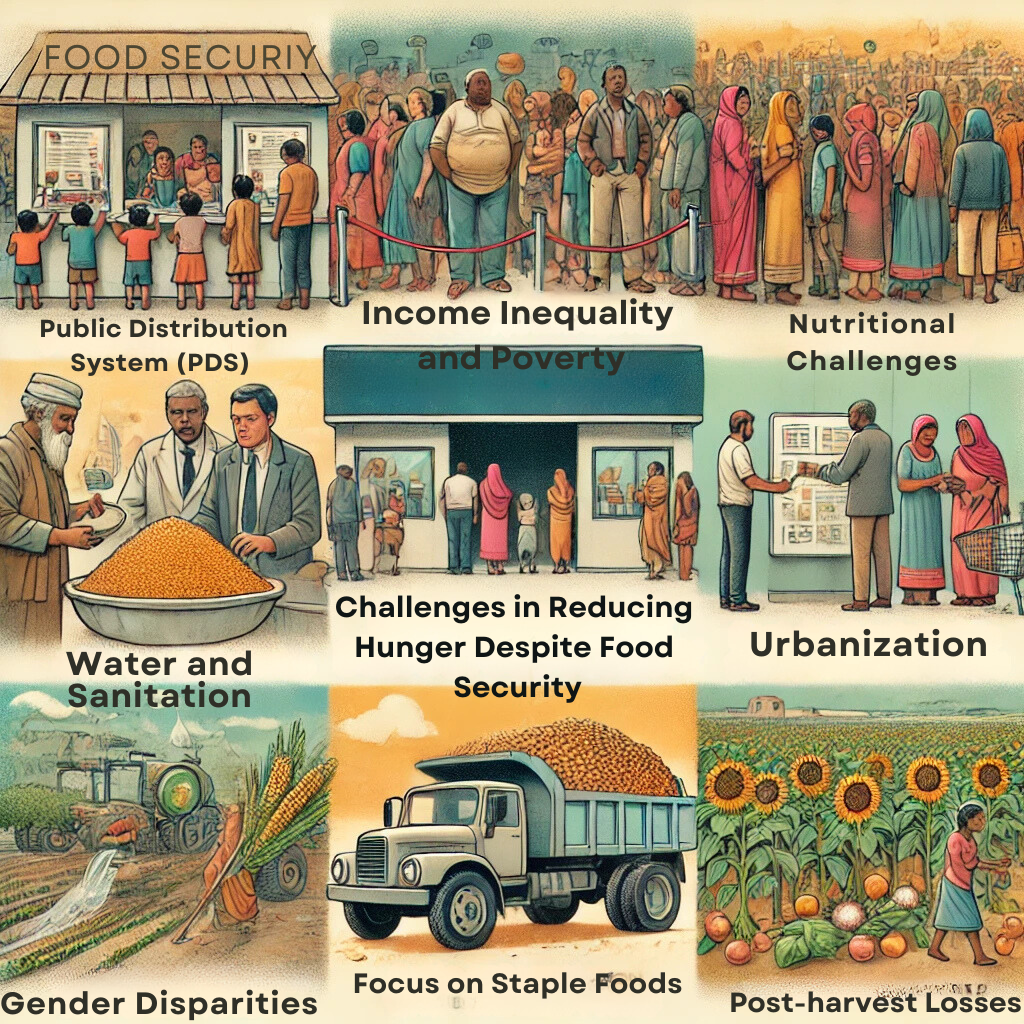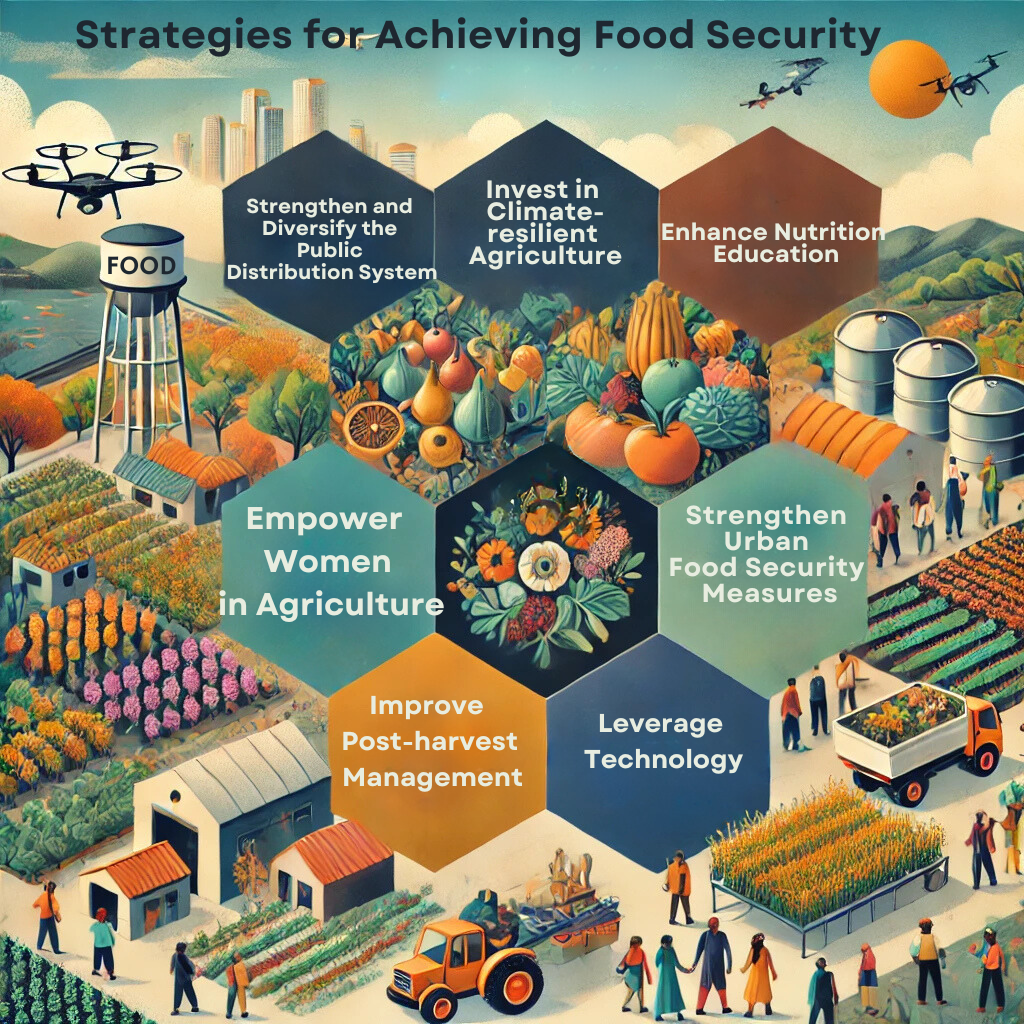India has made remarkable progress in food production, yet the challenge of ensuring food security and addressing malnutrition persists. Despite the country’s achievements, millions of Indians still struggle to access affordable, nutritious diets. This editorial delves into the global issues of food insecurity and malnutrition, highlighting the roles of rising costs, conflicts, and climate change. It underscores the need for India to shift its focus from mere food sufficiency to guaranteeing universal access to healthy diets, urging a transformation in the agri-food system to effectively tackle hunger and malnutrition.
| GS Paper | GS Paper II |
| Topics for UPSC Prelims | Food insecurity, malnutrition, National Food Security Act, International Food Security Assessment , Global Hunger Index(GHI) 2023, One Nation, One Ration Card, Household Consumption Expenditure Survey, POSHAN Abhiyaan, National Family Health Survey 5 , Agriculture Infrastructure Fund. , National Food Security Act (NFSA) 2013, National Food Security Mission, National Agriculture Market (e-NAM) Platform, National Food Processing Mission, Pradhan Mantri Fasal Bima Yojana (PMFBY), National Horticulture Mission |
| Topics for UPSC Mains | Issues Related to Food Security and Hunger in India, Government Initiatives Related to Food Security and Elimination of Hunger |
Origin of the Article
This editorial is based on “A food-sufficient India needs to be hunger-free too,” published in The Hindu on October 16, 2024. The article discusses global food insecurity and malnutrition, emphasizing the rising costs, conflicts, and climate change as key factors affecting access to nutritious food.
Relevance for UPSC Aspirants
This is an important topic for UPSC aspirants as it is covered under the General Studies paper on poverty, hunger, and agricultural resources. This knowledge would enrich their understanding of the policies of the government and socio-economic issues and prepare them for the Prelims as well as the Mains examination.
Why in News?
It is one of the crucial topics for UPSC aspirants because the problem of food security and hunger persists across the globe dominating the headlines and increasing in significance because of rising costs and heated conflicts and climatic changes. It is the reflection of India’s march forward in terms of agricultural production against the nutritional inequality mainly focusing on food security questions related to poverty and governmental measures adopted in the past to show better comprehension of the socio-economic dynamics.
Current Status of Food Security and Hunger in India
Food security paradox remains a challenge to this very agricultural power, India. Where there is food sufficiency, sections of the population suffer from hunger and malnutrition. In this sense, it is an attestation to the fact that the goal of agricultural success alone cannot bring food security to every citizen’s table but it requires a multifaceted approach to be achieved so that every Indian citizen can receive food on their plates.
Food Security
According to the International Food Security Assessment, in 2022-23, 333.5 million Indians were exposed to food insecurity. The projection goes into decline to 24.7 million in the next decade; however, affordability remains a key issue. About 63.3% of the rural population cannot afford a demanded diet if they spend all their income on food, underlining stark economic disparities and strong urgency for interventions.
Hunger in India (NSSO Statistics)
In the grain, India’s great strides into agriculture, hunger still lingers. According to data from the NSSO, 3.2 percent of Indians do not have a full meal, while 2.5 percent cannot get two square meals a day. Such disparities are echoed when India stands at 111th position in the Global Hunger Index. Though the index has been criticized for overemphasizing nutrition and child mortality, it is believed that it overemphasizes nutrition and child mortality, which might bend the facts about true hunger levels.

Reasons Why Food Security in India Has Not Translated into Reduced Hunger
Systemic inefficiencies and socio-economic imbalances in India hinder the progress in the fight against hunger by converting food security into actual nutritional improvements. These challenges need policy reforms that focus on ensuring that food availability is translated into improvement in nutrition levels, and it addresses various setback factors involved to provide effective food delivery and access in the country.
Inefficient Public Distribution System (PDS)
India’s PDS has witnessed little change in the leaky, corrupt, and exclusion-ridden functionality. Till 2022, more than 90 million eligible individuals were excluded from entitlements. Pandemic attention to failures, especially for migrants, focused on it. “One Nation, One Ration Card” should have solved the problems but is still not fully implemented and hence requires further efforts to bring in an all-inclusive system.
Income Inequality and Poverty
India’s economic growth has an underbelly of income inequality and therefore impacts food access. The World Inequality Report 2022 shows the richest 10% claim just as much an even 57% share of national income. Poverty and nutritional deficiency remain issues despite declines in poverty, with 35.5% of children under five stunted by malnutrition, as per the National Family Health Survey-5. These disparities call for equitable distribution of resources to redress hunger.
Nutritional Challenges and Dietary Diversity
It emphasizes calorie sufficiency rather than nutritional sufficiency, thus putting a triple burden of malnutrition: undernutrition, micronutrient deficiencies, and obesity. The Household Consumption Expenditure Survey 2022-23 indicates inadequate calorie intake in rural India. POSHAN Abhiyaan initiatives focused on building strong competitiveness in the ‘nutrition fight’, though still have slow progress; a deeper focus is needed on dietary diversity and nutrition.
Urbanization and Changing Food Systems
It plays havoc in the changing food systems; the urban food environment aggravates food insecurity. There is a challenge especially among the poor and vulnerable groups of accessing nutritious food in these cities. A 2022 study revealed that 51% of Delhi’s urban slum households have been found to be suffering from food insecurity. Various initiatives like Pradhan Mantri Garib Kalyan Anna Yojana remain an issue for providing adequate nutritional requirements to the people who are in need.
Gender Disparities in Food Access
Gender inequalities affect significantly on food security and nutrition in India. Girls and women of course are forced to eat last and least with implied negative implications for nutritional outcomes. According to the National Family Health Survey-5, women aged 15-49 had an anemia prevalence of 57%. Some targeted policies are required to improve the access of women to nutrition and health care to achieve some degree of fairness in food security.
Inadequate Focus on Non-staple Foods
India’s food policies have traditionally been cereal-based, concentrating on wheat and rice, at the total expense of diversified, nutrient-dense foods. It is the world’s second-largest wheat producer and has focussed on nutritional variety in its cereal-based approach and it calls for shifting towards promoting diversity in production and consumption of nutrient-dense foods to improve the diet in general and relieve nutritional deficiencies.
Post-harvest Losses and Food Waste
India sees huge post-harvest losses, with the same at the core cause. Thirty-to forty percent of fruits and vegetables perish just because of inadequate cold storage. The steps in Agriculture Infrastructure Fund aiming to overcome this issue are still slow till June 2024, with only ₹28,171 crores having been disbursed so far. Good storages and processing infrastructure need to be put in place to minimize waste and increase food security.
Limited access to Clean Water and Sanitation
Food security relates directly to WASH conditions. Nutrient malabsorption and disease caused by poor sanitation and unsafe water undermine food security, even while total progress comes through the Swachh Bharat Mission. 163 million Indians do not have access to clean water, and water accounts for 21% of all communicable diseases; solutions are urgently needed for nutritional and health outcomes improvements.
Government Initiatives Related to Food Security and Elimination of Hunger
The new government of India has undertaken so far a wide range of policies to strengthen food security and struggle against hunger. The possible measures range from legislation to specific programs: From general laws to specific programs, these measures aim to address the intricacies in such an endeavor: ensuring that everyone gets access to food and satisfies his or her nutritional needs, outlining the serious commitment of the nation toward the eradication of hunger.
Food Security Initiatives
The key initiatives include the Essential Commodities Act, NFSA 2013, and National Food Security Mission, amongst others. The aims of these initiatives are stabilizing food supply, improving agricultural productivity, and access to essential commodities. This would be supported by improvement in market access and infrastructure through the National Agriculture Market (e-NAM) Platform and the Mega Food Park Scheme.
Hunger Alleviation Programs
While initiatives under Nutrition and Hunger like the Eat Right India Movement, POSHAN Abhiyan, and the Mid-day Meal scheme are aimed at nutrition and hunger, there are programs aimed at different sections of society – children and pregnant women, which advocate nutritionally balanced dieting and nutritional awareness. Innovations in the form of the POSHAN Tracker App improve monitoring and implementation.

Strategies for Achieving Food Security and Reducing Hunger
Only by a multifaceted approach can the problems of food security and hunger in India be dealt with. Targeted strategies and reforms are needed for real enhancement to take place in access, nutritional adequacy, and well-being of populations and usher them to a hunger-free future.
Strengthen and Diversify the Public Distribution System (PDS)
Expansion of PDS to incorporate pulses and millets will help improve the nutritional quality. Technological means would be helpful if applied for better targeting and the reduction of leakages in general. This “One Nation, One Ration Card” will ensure that the food reaches all the migrants. That will make the entire system more effective and inclusive.
Invest in Climate-resilient Agriculture
Key to such adaptive practices is to promote drought-tolerant crops and water-saving irrigation. Crop insurance schemes such as Pradhan Mantri Fasal Bima Yojana expand, shielding the farmer from shocks of climate change. An example is in research to develop flood-tolerant rice and other climate-resilient technologies, supporting sustainable agricultural development.
Enhance Nutrition Education and Behavior Change
Improving diets can be contributed to by mass communication of nutritional education programs addressing different populations. Nutrition education must be integrated as an essential component in school curriculums. And utilization of technological avenues for outreach is very fundamental. Scaling up models that have been successful, such as POSHAN Abhiyan’s Jan Andolan. It can help in the creation of mass awareness and build durable behavior change.
Strengthen Urban Food Security Measures
Targeted programs for urban areas-neighborhood kitchens, urban agriculture can address the challenge of urban food insecurity. Engagement with civil society organization as well as better identification of vulnerable populations enhances outreach. Scaling up successful models like the Akshaya Patra centralized kitchens improves food distribution in urban areas.
Promote Dietary Diversification and Indigenous Foods
In this regard, diversified, locally adapted crop varieties like millets and pulses would certainly improve diet quality. Small food processing units have to be encouraged, and campaigns may be initiated based on nutritional values of traditional foods. The government proclamation of 2023 as International Year of Millets is also a step in the right direction.
Empower Women in Agriculture and Nutrition
Land ownership and acquisition of agricultural inputs enhances food security for women. The above components include provision of targeted extension services and financial literacy trainings. They are for the women farmer, as well as improvements in the self-help groups. Projects like Mahila Kisan Sashaktikaran Pariyojana are a great example of its high potential for empowering women in agriculture effectively.
Improve Post-harvest Management and Reduce Food Waste
Use of post-harvest facilities, cold chains, and processing units will reduce considerably the losses generated from the harvesting process. Superior inventory management technologies and public-private partnerships in agri-logistics infrastructure must be adopted. Effectiveness is achieved by local-level storage and processing facilities.
Enhance Social Protection for Informal Workers
Social security measures can be expanded, and urban employment guarantee schemes can be launched to complement informal workers. Strengthening the link between social protection programs and nutrition programs, as already initiated by Odisha and Rajasthan. These initiatives can serve as templates for greater widespread implementation in view of improving their food security and livelihoods.
Implement a Life-cycle Approach to Nutrition
A 360-degree nutrition intervention design at specific stages of life from pregnancy to old age. It will be a feature of these programs. Some of these include strengthening programs like Integrated Child Development Services, initiating new programs for adolescents and the elderly. And also extension of successful models across geographies, which can improve nutrition across the demographies.
Leverage Technology for Better Targeting and Monitoring
Applying AI and big data improves targeting through real-time monitoring of food security through early warning systems. Efficiency in system handling is enhanced through satellite imagery for predicting crop yield and mobile apps to access the beneficiaries. An example in this regard would be the “Mera Ration” app, which gives an example of what is possible through use of technology in food security service delivery.
PESTEL Analysis
| Political: Government schemes like the National Food Security Act, POSHAN Abhiyan, and PDS reforms aim to address food insecurity. However, corruption and inefficiency in these programs remain challenges. Economic: Income inequality and poverty significantly affect access to nutritious food. The rising cost of healthy diets exacerbates food insecurity, particularly for the rural poor. Social: Nutritional disparities persist, with gender norms often leading to women and children suffering from malnutrition. A focus on staple foods and neglect of nutritional adequacy is widespread. Technological: Use of AI and advanced technology in food distribution and post-harvest management can improve efficiency and reduce wastage, though implementation is still lagging. Environmental: Climate change and water scarcity impact food production, necessitating investments in climate-resilient agriculture to ensure food security. Legal: Policies such as “One Nation, One Ration Card” aim to improve food distribution but require better implementation and enforcement to reduce exclusion errors and corruption. |
Conclusion
Ensuring food security and the elimination of hunger in India is central to national development. Strengthening the PDS, investing in climate-resilient agriculture, and promoting dietary diversity are, therefore, avenues for transforming India’s agri-food systems. This will not only be a concrete step toward addressing hunger but also enhance good health and well-being according to the global commitment of eradicating hunger by 2030.
| UPSC Civil Services Examination, Previous Year Questions (PYQs) Mains Q. How can e-commerce help in overcoming bottlenecks in marketing and supply chain management in developing the food processing industry in India? Discuss. (UPSC Mains 2015, GS Paper II) Q. Discuss the role of the National Food Security Act (NFSA) in addressing food insecurity in India. How can the integration of ‘One Nation, One Ration Card’ system improve the effectiveness of NFSA in ensuring equitable access to food grains? |



